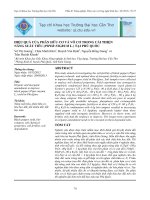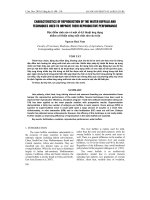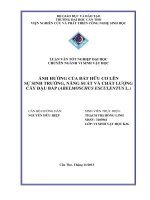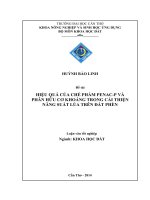Cải thiện năng suất và lợi nhuận bắp lai bằng biện pháp bón phân theo địa điểm chuyên biệt và mật độ cây
Bạn đang xem bản rút gọn của tài liệu. Xem và tải ngay bản đầy đủ của tài liệu tại đây (380.12 KB, 5 trang )
Omonrice 16: 88-92 (2008)
OMONRICE 16 (2008)
IMPROVING OF MAIZE YIELD AND PROFITABILITY THROUGH SITE-SPECIFIC
NUTRIENT MANAGEMENT (SSNM) AND PLANTING DENSITY
Trinh Quang Khuong
1
, Pham Sy Tan
1
and Christian Witt
2
1
Agronomy Department, Cuu Long Rice Research Institute, Cantho City, Vietnam
Email:
2
International Plant Nutrition Institute (IPNI), Southeast Asia Program, Singapore
ABSTRACT
Maize is the second most important cereal crop after rice in Southeast Asian countries.
Currently, recorded average maize yields as compared to the yield potential for a given
variety and climate indicate significant opportunities to further increase maize productivity
through site-specific, integrated nutrient and crop management. The on-farm experiments
were conducted at Tan Chau district, An giang Province, Vietnam in 2006 dry season and
2006 wet season on maize-maize-rice cropping system. The 10 treatments were the
combination of planting densities: regular density 67,000 plants ha
-1
(75x20cm), and
improved planting density (iPD) 50x30cm, and ICM with high plant density 74,000 plants
ha
-1
(75x18cm), and fertilizer application methods: FFP (fertilizer farmer practices), SSNM
and the omission plots of N, P and K on five farmer fields in a randomized completed block
design. The results revealed that maize yields of 8-10 t ha
-1
can be achieved in Tan chau, An
giang. The highest yield was recorded at 9.85 t ha
-1
on alluvium soil in dry season and 8.58
t ha
-1
in wet season. Yields increased of about 0.3-0.4 t ha
-1
by increasing plant density. At
planting density of 67,000 plants ha
-1
, improved plant density (50x30 cm) gave a better
grain yield as compared to farmer’s planting density (75x20 cm). Improved planting density
with higher NPK rate of SSNM got higher grain yield by 0.7 t ha
-1
and higher net benefit by
833 thousand VND ha
-1
and 786 thousand VND ha
-1
in 2006 DS and 2006 WS, respectively.
Keywords: fertilizer farmer practices (FFP), grain yield (GY), improved planting density
(iPD), Integrated Crop Management (ICM), Regular density (Reg), Site-Specific Nutrient
Management (SSNM)
INTRODUCTION
In Vietnam as well as in many Southeast Asia
countries, maize is the second most important
cereal crop after rice. Although the maize area and
yield continuously increased in recent years, it get
lower grain yield than that of other countries.
Otherwise, the maize productivity of Vietnam as
well as in the Mekong Delta is very large, in which
An giang is one of provinces fairly yielded 7.4 t/ha
with 8,900 ha in 2004 and its productivity obtained
77,000 tons. For getting the best goal, the
approaches are quickly expansion of growing
areas of good maize varieties and combined with
intensive crop managements. Moreover, currently
recorded average maize yields compared with the
yield potential for a given variety and climate
indicate significant opportunities to further
increase maize productivity through site-specific,
integrated nutrient and crop management
(Dobermann et al. 2003; Witt et al. 2004). The
research aims at determining the effect of Site-
Specific Nutrient Management (SSNM) and
improving planting density on grain yield and
economic efficiency.
MATERIALS AND METHODS
The experiments were conducted in five farmer
fields at Tanchau, An giang in 2006 dry season
and 2006 wet season on the Maize-Maize-Rice
cropping pattern. The experiment was comprised
of ten treatments, which were the combination of
planting densities and fertilizer application
methods. The planting densities were 67.000
plants/ha with spacing of 75x20 cm. Improved
planting density (iPD) was recommended as 50x30
cm and high plant density of ICM (74.000
Improving of maize yield and profitability through site-specific nutrient management...
OMONRICE 16 (2008)
89
plants/ha) with spacing of 75x18 cm. The fertilizer
application methods included of fertilizer farmer
practice (FFP) and Site-Specific Nutrient
Management (SSNM) (Table1). The omission
fertilizer plots were +PK, +NK and +NP.
The experimental soil was a loamy alluvium with
the contents of 40% sand, 51% silt and 9% clay at
0-20 cm layer and 40% sand, 49% silt and 11%
clay at 20-40 cm layer. The chemical soil
properties were low in organic C and total N,
medium-high in P, low-medium in K, low in Ca
and Mg, no micro-nutrients deficiency and no soil
toxicity.
The maize variety of G49 with 90-95 days growth
duration was used in both seasons.
Data of yield components and grain yield were
collected and calculated the economic efficiency
of improvement of planting density and fertilizer
application method followed by the procedure of
IRRI (Fairhurst et al. 2005) and IPNI.
Table 1: Fertilizer rate in FFP and SSNM treatments for maize G49 at Tanchau, An giang.
FFP (kg/ha) SSNM (kg/ha)
N P
2
O
5
K
2
O N P
2
O
5
K
2
O
06 DS 180 91 71 200 120 100
06 WS 166 83 73 200 120 100
RESULTS AND DISCUSSIONS
Effect of planting density and fertilizer
application methods on yield components and
grain yield
In 2006 DS and 2006 WS, the ears no./ha among
fertilizer treatments and planting densities varied
from 65,000-73,000 ears/ha at iPD-50x30cm and
ICM. The kernel No/ear got highest value at the
SSNM and plant density 75x20 cm treatment (471
kernels /ear in 2006 DS and 416 kernels /ear in
2006 WS). The difference on the kernel No/ear
was very clear between the omission plots of NK
and NP. The SSNM treatment got the higher ear
No/ha than that of FFP treatment. The treatment of
FFP and iPD-50x30cm got the higher ear No/ha
than that of regular plant density 75x20 cm. The
averaged weight of 100 grains of G49 varied from
27 to 28.6 g at the SSNM and FFP treatments, but
it only got from 21-27.6 g in the omission fertilizer
treatments (Fig.1 and 2)
The grain yield of G49 got the highest value at
SSNM and improved planting density (iPD-50x30
cm). It got 9.85 t/ha in 2006 DS and 8.58 t/ha in
2006 WS. The combined treatment of FFP and
ICM plant density-75x18cm got higher grain yield
than that of the FFP and regular planting density
75x20 cm treatment. No nitrogen fertilizer
application, the grain yield was very low. It got
only 1.8 t/ha in 2006 DS and 3.8 t/ha in 2006 WS.
Without phosphorus, the grain yield of WS was
lower than that of DS. It got 6.9 t/ha in 2006 WS
compared to 8.3 t/ha in 2006 DS (Fig.1 and 2).
These data affirmed that had a high need of
nitrogen nutrient for hybrid maize. The SSNM
method with higher applied-nutrients, especially
nitrogen, adequately responded the plant need that
led to getting higher grain yield than FFP
treatment (Table 1).
Effect of planting density and fertilizer
application methods on profitability of maize
Compared to FFP, SSNM method combined with
improved planting density (iPD) gave the highest
profit for both seasons (Table 2 and 3). The
increased profit of SSNM-iPD treatment was VND
833,000 / ha in 2006 DS and VND 786,000 / ha in
2006 WS. The profit was increased by high plant
density (ICM) of VND 444,000 / ha in 2006 DS
and VND 401,000 / ha in 2006 WS.
Trinh Quang Khuong et al.
OMONRICE 16 (2008)
90
Fig 1: Comparison of GY and the ear size of maize G49 under effect of planting densities and fertilizer
rates.
Fig 2: Grain yield and yield components of Maize G49 at Tanchau, An giang in 2006 WS.
Improving of maize yield and profitability through site-specific nutrient management...
OMONRICE 16 (2008)
91
Table 2: Economic analysis of planting densities and fertilizer application methods on maize G49 at
Tanchau, An giang in 2006 DS.
Treatments
FFP-Reg
(75x20cm)
FFP-ICM
(75x18 cm)
SSNM-iPD
(50x30 cm)
SSNM –ICM
(75x18 cm)
Grain yield (t/ha) 9.14 9.42 9.85 9.56
Prize of maize (VND/kg) 1800 1800 1800 1800
Gross benefit (1000 VND/ha) 16452 16956 17730 17208
Fertilizer cost (1000 VND/ha) 3377 3377 3822 3822
Seed cost(1000 VND/ha) 579 639 579 639
Net benefit (1000 VND/ha) 12496 12940 13329 12747
Profit (fertilizer)(1000VND/ha) 833 -193
Profit (plant density)(1000VND/ha) 444 -582
Table 3: Economic analysis of planting densities and fertilizer application methods on maize G49 at
Tanchau, An giang in 2006 WS.
Treatments
FFP-Reg
(75x20cm)
FFP-ICM
(75x18 cm)
SSNM-iPD
(50x30 cm)
SSNM –ICM
(75x18 cm)
Grain yield (t/ha) 7.87 8.07 8.58 8.39
Prize of maize (VND/kg) 2300 2300 2300 2300
Gross benefit (1000 VND/ha) 18101 18561 19734 19297
Fertilizer cost (1000 VND/ha) 3025 3025 3871 3871
Seed cost(1000 VND/ha) 561 619 561 619
Net benefit (1000 VND/ha) 14516 14917 15302 14806
Profit (fertilizer)(1000VND/ha) 786 -111
Profit (plant density)(1000VND/ha) 401 -496
CONCLUSION
Maize yield of 8-10 t ha
-1
can be achieved in
Tanchau, An giang. The highest yield was
recorded at 9.85 t ha
-1
on alluvium soil in dry
season and 8.58 t ha
-1
in wet season. Yield
increased of about 0.3-0.4 t ha
-1
by increasing plant
density. Grain yield increased 0.14-0.32 ha
-1
by
SSNM method. At planting density of 67,000
plants ha
-1
, improved plant density (50x30 cm)
gave a better GY as compared to farmer’s planting
density (75x20 cm). Improved planting density
with higher NPK rate of SSNM, the GY was
recorded higher by 0.7 t ha
-1
and the profit of
maize production was increased by VND 833,000
and VND 786,000 in 2006 DS and 2006 WS,
respectively.
REFERENCES
Dobermann A, T Arkebauer, KG Cassman, RA
Drijber, JL Lindquist, JE Specht, and DT
Walters. 2003. Changes in nitrogen use
efficiency and soil quality after five years of
managing for high yield corn and soybean. In:
Murphy, L.S. (Ed.), Fluid focus: the third
decade. Proceeding of the third decade of the
2004 Fluid Forum, Vol. 21. Fluid Fertilizer
Foundation, Manhattan K.S, pp.73-79.
Fairhurst TH, A Dobermann, and C Witt. 2005.
Fertilizer Chooser (Software). Available at
www.seap.sg (accessed 20 May 2005).
Lincoln, NE: University of Nebraska,
Singapore: Pacific Rim Palm Oil Limited, Los
Banos, Philippines: International Rice
Research Institute (IRRI).
Witt C, RJ Buresh, V Balasubramanian, D Dawe
and A Dobermann. 2004. Principle and
promotion of site-specific nutrient
Trinh Quang Khuong et al.
OMONRICE 16 (2008)
92
management. In Increasing productivity of
intensive systems through site-specific nutrient
management. Enfield N. H. (USA) and Los
Banos (Philippines): Science Publishers, Inc.,
and International Rice Research Institute
(IRRI).pp 397-410.
Cải thiện năng suất và lợi nhuận bắp lai bằng biện pháp bón phân
theo địa điểm chuyên biệt và mật độ cây
Ở các nước Đông Nam Á, bắp là cây lương thực quan trọng đứng thứ hai sau lúa. Các ghi nhận gần đây
cho thấy năng suất bắp trung bình so với tiềm năng suất của một giống trong điều kiện khí hậu nhất định
có cơ hội gia tăng hơn nữa bằng biện pháp quản lí cây trồng và dinh dưỡng tổng hợp. Các thí nghiệm
đồng ruộng được thực hiện trên 05 ruộng nông dân ở Tân Châu, An Giang trong hai vụ ĐX2005-06 và
HT2006 trên cơ cấu 3 vụ bắp-bắp- lúa/năm. Thí nghiệm được bố trí theo khối hoàn toàn ngẩu nhiên với
10 nghiệm thức là sự kết hợp giữa 3 mật độ cây (75x20 cm, 50x30cm và 75x18 cm) và các phương bón
phân (bón phân theo nông dân-FFP; bón phân theo địa điểm chuyên biệt-SSNM; các lô khuyết không
bón phân N, P và K).
Năng suất bắp ở Tân Châu, An Giang có thể đạt được từ 8-10 t/ha. Năng suất bắp cao nhất trên đất phù
sa trong vụ ĐX05-06 là 9,85t/ha và 8.58 t/ha trong vụ HT2006. Năng suất gia tăng do cải thiện mật độ
cây là từ 0,3-0,4 t/ha. Ở mật độ 67.000 cây/ha, khoảng cách cải tiến iPD (50x30 cm) đạt năng suất cao
hơn so với mật độ trồng của nông dân (75x20 cm). Mật độ cây cải tiến kết hợp với mức phân bón cao
hơn của SSNM gia tăng được 0,7 t/ha và gia tăng lợi nhuận được 833 ngàn đồng/ha trong vụ ĐX05-06
và 786 ngàn đồng/ha trong vụ HT2006.









